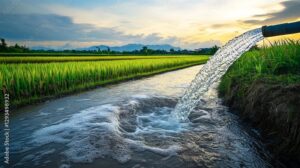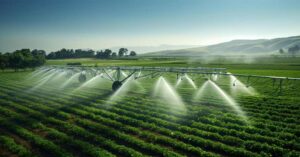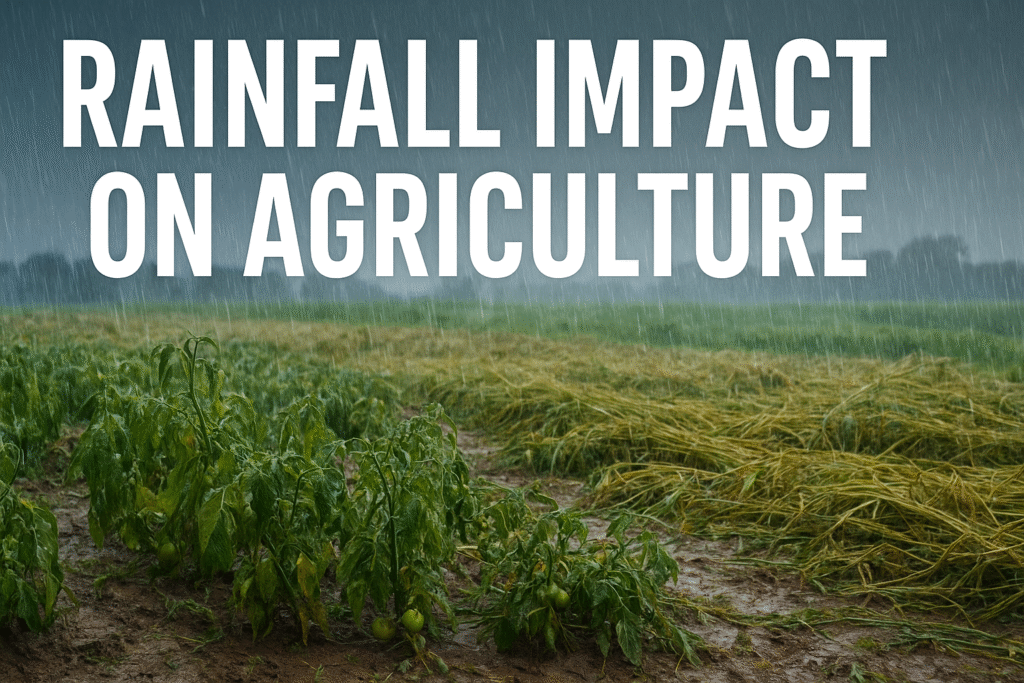🌧️ Rainfall Impact on Agriculture: Effects on Crops, Farmers, and Food Prices
Rainfall is the lifeline of agriculture. But while timely monsoons bring prosperity, heavy rains often damage crops like vegetables and pulses, causing food shortages and price hikes.
Farmers across India face huge challenges due to unseasonal rainfall and climate change, making agriculture more unpredictable than ever.
🌱 Positive Effects of Rainfall on Agriculture
Rain, when balanced, can be highly beneficial for farming. Some advantages include:
- Natural irrigation – Reduces dependence on artificial irrigation systems.
- Improved soil fertility – Recharges groundwater and boosts soil nutrients.
- Higher crop yield – Timely rainfall supports rice, wheat, maize, and pulses growth.
- Livestock benefits – Increases availability of fodder and drinking water.

✅ Example: In states like Punjab and Bihar, timely monsoon rains often lead to bumper rice harvests.
⚠️ Negative Impact of Heavy Rainfall on Crops
When rains become excessive or arrive at the wrong time, agriculture suffers badly. Here’s how:
🌿 Vegetable Crop Loss due to Heavy Rain
- Tomatoes, onions, and leafy vegetables rot due to waterlogging.
- Excess moisture causes fungal infections in crops.
- Supply shortage leads to vegetable price rise in markets.
🌾 Pulses Crop Damage and Farming Challenges
- Pulses like arhar (toor dal), urad, and moong fail to flower in extreme rainfall.
- Standing crops like wheat and maize get flattened due to waterlogging.
- Pulses shortage directly affects dal prices for consumers.
💰 Farmer Losses and Economic Impact
- Farmers lose entire harvests, leading to debt and financial crisis.
- Local laborers lose daily employment opportunities.
- Food supply chains are disrupted, impacting urban markets.

✅ Example: In Maharashtra, heavy rains in 2023 damaged onion crops, pushing onion prices to record highs.
🌍 Climate Change and Unseasonal Rainfall in Agriculture
Climate change has made rainfall unpredictable, directly impacting farming. Some key challenges include:
- Sudden cloudbursts damaging standing crops.
- Dry spells followed by heavy downpours causing soil erosion.
- Unseasonal rainfall destroying ready-to-harvest crops.
🌐 Learn more about climate change and agriculture.
💡 Solutions: How Farmers Can Cope with Rainfall Damage
To fight unpredictable rainfall, farmers are adopting innovative practices:
- Crop diversification – Growing both short-term and long-term crops to balance risk.
- Rainwater harvesting – Storing rainwater for dry spells.
- Climate-resilient seeds – Flood and pest-resistant varieties.
- Crop insurance schemes – Government support like Pradhan Mantri Fasal Bima Yojana.
👉 Farmers can also check our guide on crop insurance benefits in India.
📈 Consumer Impact: Food Price Rise After Heavy Rain
When rains damage crops, it is not just farmers who suffer—consumers also feel the impact:
- Vegetable price rise due to supply shortage.
- Dal price hike as pulses harvest reduces.
- Transport delays from floods affect supply chains.

✅ Conclusion: Balancing Rainfall and Agriculture
Rainfall will always remain a blessing and a challenge for farmers. Rainfall Impact on Agriculture While it nourishes crops, excessive rains can destroy months of hard work.
By adopting climate-smart farming practices, government support schemes, and modern technology, farmers can better protect themselves from losses.
📢 Call to Action
Have you noticed vegetable or pulses prices rising in your local market after heavy rains?
Share your thoughts in the comments, and don’t forget to explore our agriculture insights for more updates.

